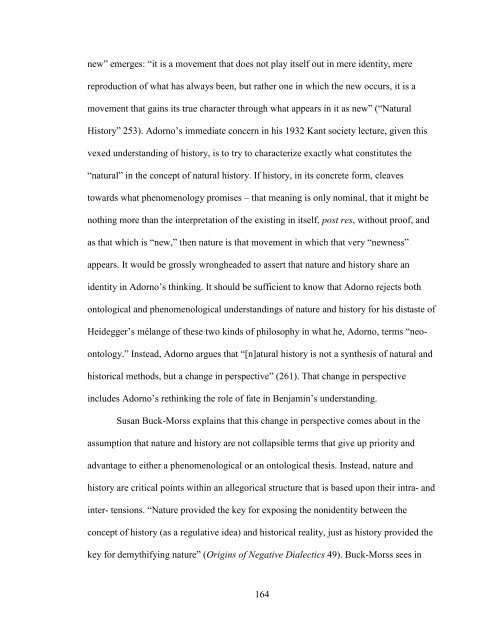TABOO: THE ACTUAL MODERNIST AESTHETIC, MADE REAL A ...
TABOO: THE ACTUAL MODERNIST AESTHETIC, MADE REAL A ...
TABOO: THE ACTUAL MODERNIST AESTHETIC, MADE REAL A ...
Create successful ePaper yourself
Turn your PDF publications into a flip-book with our unique Google optimized e-Paper software.
new‖ emerges: ―it is a movement that does not play itself out in mere identity, mere<br />
reproduction of what has always been, but rather one in which the new occurs, it is a<br />
movement that gains its true character through what appears in it as new‖ (―Natural<br />
History‖ 253). Adorno‘s immediate concern in his 1932 Kant society lecture, given this<br />
vexed understanding of history, is to try to characterize exactly what constitutes the<br />
―natural‖ in the concept of natural history. If history, in its concrete form, cleaves<br />
towards what phenomenology promises – that meaning is only nominal, that it might be<br />
nothing more than the interpretation of the existing in itself, post res, without proof, and<br />
as that which is ―new,‖ then nature is that movement in which that very ―newness‖<br />
appears. It would be grossly wrongheaded to assert that nature and history share an<br />
identity in Adorno‘s thinking. It should be sufficient to know that Adorno rejects both<br />
ontological and phenomenological understandings of nature and history for his distaste of<br />
Heidegger‘s mélange of these two kinds of philosophy in what he, Adorno, terms ―neo-<br />
ontology.‖ Instead, Adorno argues that ―[n]atural history is not a synthesis of natural and<br />
historical methods, but a change in perspective‖ (261). That change in perspective<br />
includes Adorno‘s rethinking the role of fate in Benjamin‘s understanding.<br />
Susan Buck-Morss explains that this change in perspective comes about in the<br />
assumption that nature and history are not collapsible terms that give up priority and<br />
advantage to either a phenomenological or an ontological thesis. Instead, nature and<br />
history are critical points within an allegorical structure that is based upon their intra- and<br />
inter- tensions. ―Nature provided the key for exposing the nonidentity between the<br />
concept of history (as a regulative idea) and historical reality, just as history provided the<br />
key for demythifying nature‖ (Origins of Negative Dialectics 49). Buck-Morss sees in<br />
164
















